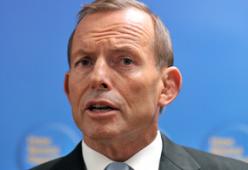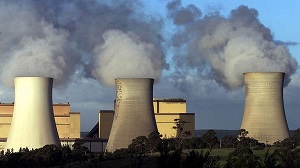This post brings together a number of items on renewable power including US windpower agreements setting the price as low as $US25 MWh (2.5 cents/kWh. WA thinking of importing Indonesian coal for power generation while ignoring renewables and approval being given by the Pt Augusta council for a solar thermal installation that will be used to desalinate water and heat/cool 20 hectares of greenhouses for tomato growing.
Category Archives: Politics & Government
Joe Hockey Puts His Foot in His Mouth Again
Joe Hockey’s claim that “Poor people don’t have cars, don’t drive far.” seriously failed the ABC Factcheck test. But what he said was an exercise in stupidity that went far beyond getting some facts wrong. It reinforced the perception that Joe is a man on a class war against what he sees as the unentitled poor. Worse still, Continue reading Joe Hockey Puts His Foot in His Mouth Again
The RET Needs Bipartisanship- Contract Based Alternatives Don’t
Tony Abbott has already killed the Howard government’s RET scheme. No new large scale energy projects directly justified by the RET have been committed to since the start of 2013. In addition, since the Abbott government was elected, the price of large-scale renewable energy certificates had nearly halved to $26.00 per MWh by 11 Aug 14. To make things worse, the RET is not going to be resurrected by a change of government or action by the Senate.
Continue reading The RET Needs Bipartisanship- Contract Based Alternatives Don’t
Will unemployment be reduced if immigration is slowed down?
Rob Burgess of Business Spectator argued that skilled immigration will help reduce unemployment The Burgess article starts with: Continue reading Will unemployment be reduced if immigration is slowed down?
Climate clippings 104
This edition begins with the weather and ends with a sad tale of revenge and tribalism as the basis for climate policy.
When we have some cooler than normal weather people are apt to say “So much for global warming!” They should realise how small a part of the globe we are.
The warmest May on record for the planet has been followed by the warmest June:
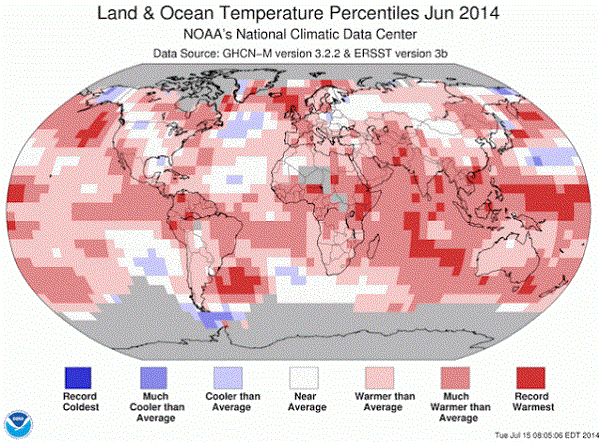
In fact June was the highest departure from average for any month on record.
The last below-average global temperature for any month was February 1985. The last below average June was in 1975 when Gough Whitlam was PM!
The majority of models still favour a spring El Niño:
Warming in the tropical Pacific Ocean since the beginning of 2014 has primed the climate system for an El Niño in 2014, although an atmospheric response is yet to be observed. As a result, the transition towards El Niño conditions has slowed in recent weeks. While five out of eight climate models surveyed by the Bureau suggest El Niño will become established by October, all have eased their strength over the past few months. Three models suggest an El Niño will not occur in 2014, while another indicates only a brief period of El Niño-like conditions.
3. Temperatures poised to rise rapidly
El Niño years are often associated with a higher than average temperature rise. However, there’s another reason temperatures may be about to rise. You may recall that around 93% of the extra global warming goes into the ocean and only 2.3% into the atmosphere:
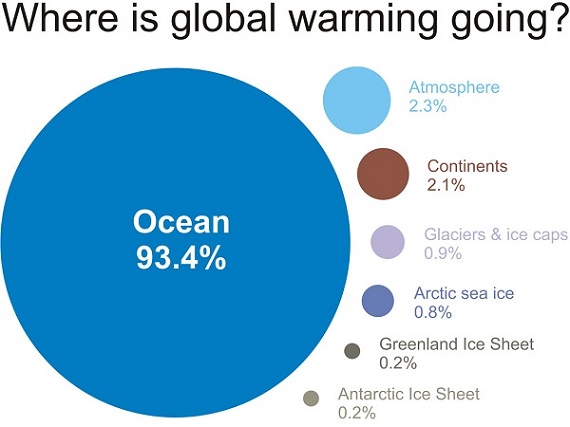
In recent years the trade winds have speeded up causing deep mixing in the ocean, taking warm water deeper displacing cooler water which rises to the surface to be warmed. Sooner or later this will stabilise, with more heat going into the atmosphere.
The article also points out the recent correction of the Hadley Centre temperature record, adding in an estimate for the polar regions, where there are no weather stations. This correction virtually eliminates the famous ‘pause’. The heavy lines show the corrected data:
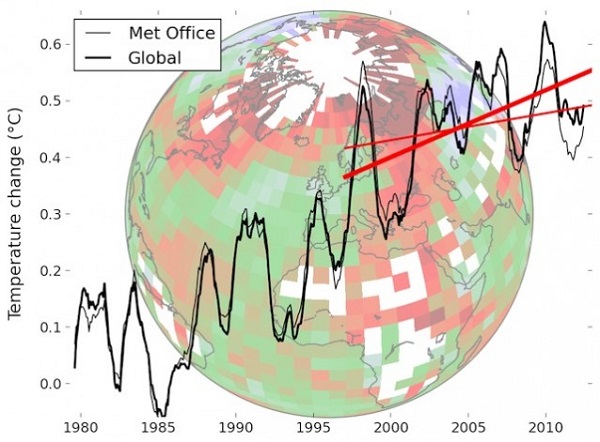
4. Onshore wind is now the cheapest form of new energy in Denmark
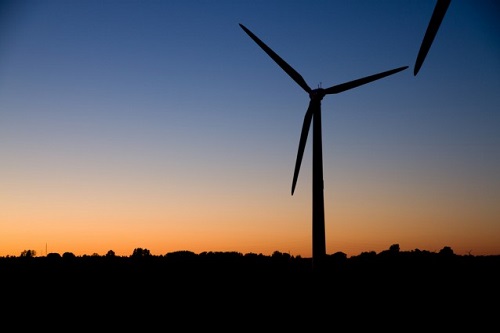
A new analysis from the government of Denmark found that wind power is by far the cheapest new form of electricity in the country. New onshore wind plants coming online in 2016 will provide energy for about half the price of coal and natural gas plants, according to the Danish Energy Agency (DEA), and will cost around five cents per kilowatt hour.
5. Abbott bets the house on coal
Meanwhile our visionary PM bets the house on coal as the world price is collapsing and countries turn to renewables.
The price for thermal coal has plunged more than 10 per cent in the last two months as the presumed major customers – China and India – make it clear that renewable energy is offering a competitive alternative to coal and gas.
The current spot market has been below the cost of production.
China may cease to import coal in a few years. The Europeans are talking about ramping up targets for emission reductions, energy efficiency and renewable energy. The Indians are
building of “mega” capacity solar farms, off-grid solar pumps for irrigators, solar installations over canals, cuts in tariffs for solar components and a doubling of the tax on coal – has been followed by an announcement that the country will look to expand a “rent-a-roof” program from solar installations initially begun in Gujarat, the home state of new PM Narendra Modi, who has promised a “saffron revolution” of solar power.
Tata Power is providing interest free loans up to $4,000 for rooftop solar.
Bloomberg New Energy Finance last week predicted solar would beat coal plants on costs by 2020. Chile has announced a whole series of large scale solar plants. On and on it goes.
Here in Sydney there was concern at the Clean Energy Week conference that Abbott can cripple renewables by doing nothing. According to one speaker
even if the 41,000GWh target was retained, and long term certainty provided, the removal of the carbon price will make it difficult to obtain financing for wind and solar farms from financial institutions.
That’s because the carbon price and the RET were designed to work together. If the carbon price is removed, then there is a massive shortfall in revenue when the certificates issued under the RET expire in 2030…
John D has been calling it but here’s a dramatic graph showing how large scale investment has stopped in its tracks:
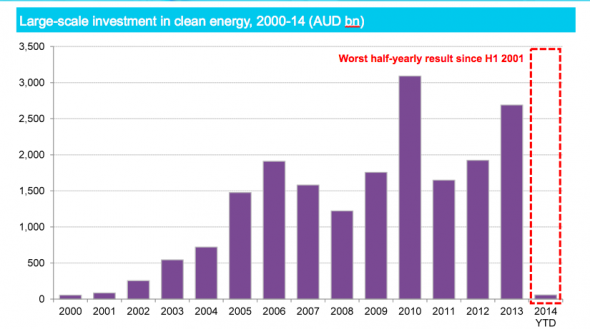
I couldn’t find a decent review of Ian Chubb’s excellent book Power failure, which traces climate policy in Australia from before the 2007 election to the installation of the Abbott government. The link in the heading is to a revealing interview with the author by The Fifth Estate. Chubb:
“[Climate change denial] is a cultural issue for the Coalition. It’s nothing to do with rationality or reason or the future or business – it’s tribal. While this government is in power we can’t recreate the consensus.
“For this government burning coal to make electricity is the equivalent to eating red meat – if you don’t, you’re a sissy. So this government will never have sympathy for making renewable energy – only sissies do that. The government has attempted to shut down everything to do with renewable energy.”
He the goes on to talk about revenge, tribalism and well-flung mud.
He describes the current policy situation as current policy situation as a “ridiculous and expensive mess”. Two things might change it. One is leadership from the US. The other is that nasty things may have to happen from the climate itself.
My sense is that the damage to confidence wrought by this mob is such that a change of government with new policies may not be enough. We need the Tea Party to get real before confidence can be restored.
I need to say more about Chubb’s book which is clear-eyed about the strengths and weaknesses of both Rudd and Gillard. Anyone wondering why some of Rudd’s colleagues thought he had to go should read this extract in The Age.
An untrustworthy, unimaginative, incompetent dunderhead
That’s how voters see their prime minister Tony Abbott, says Laura Tingle of the most recent Nielsen Poll.
More of that later, but the poll sees the ruling LNP stabilise in landslide loss territory at 54-46:
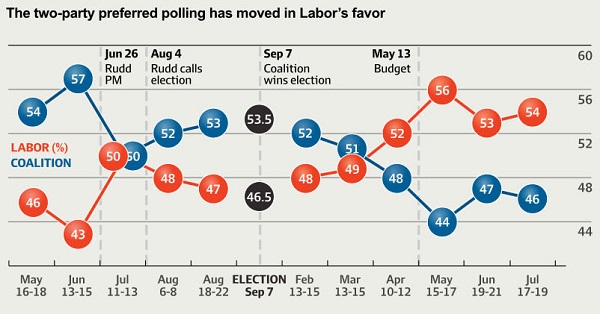
The only demographics where the LNP has a clear lead in the primary vote are the 55+ group and WA. But in WA the TPP lead is only 52-48, well within the margin of error. Queensland has turned sour for the LNP at 45-55.
Abbott’s approval rating has improved from -25 to -18. Abbott’s overall personal rating may improve further due to his handling of the response to the Ukraine air tragedy but his real problem seems to lie in the voters’ view of his personal attributes. Abbott continually hammered the Gillard government over competency and trust. He fails on both counts.
According to Nielsen, voters now rate his competence as slightly lower than Gillard’s.
They do not rate him as being as strong a leader, believe him to be even less trustworthy, and have an even weaker grasp on economics.
At least the former prime minister had a majority of voters believing she had a firm grasp on foreign and social policy – only 43 per cent of voters rate Abbott on foreign policy and 34 per cent on social policy.
Abbott has strengths (above 50%) in his clear vision for Australia’s future and in his ability to make things happen. However, his weakness on social policy is severe, contrasting with Shorten’s strength. In context Abbott’s strengths may be problematic.
Shorten emerges as a more competent and trustworthy figure, but he is yet to be seen as a strong leader with a vision for the country and an ability to make things happen. Perhaps a problem of opposition.
Shorten still heads Abbott as preferred PM but has slipped slightly from 47-40 to 46-41.
On economic policy they are even, and not very good on 45%.
Prior to the budget Joe Hockey had a clear lead over Chris Bowen as preferred treasurer at 51-34. Now they are virtually even at 43-42.
Reading opinion polls is a bit like reading tea leaves, but the Abbott government’s problems appear fundamental.
Keeping the score on PUP
In an earlier thread, I linked to Lenore Taylor’s article, which holds that the pattern with Palmer is to cause maximum drama then support government. Robert Merkel also linked to Taylor as well as to Ben Eltham who sees Palmer as following self interest.
For both of these to be true, the government must always act in Palmer’s interest, which seems unlikely.
According to Laura Tingle the Taylor view has become orthodoxy in the major parties:
Having sussed out the Palmer United Party, both sides of politics made pragmatic assessments that, for now at least, the PUP should be regarded as a noisy nuisance but one which would support the Coalition in most things.
She says this does not accord with the experience of the past two weeks:
Yes, the PUP ultimately supported the government’s carbon tax repeal bill with amendments. But it opposes the Coalition’s Climate Change Authority Abolition Bill, the Clean Energy Finance Corporation (Abolition) Bill and the bill to repeal the Australian Renewable Energy Agency.
It is also opposing moves to stop tax cuts associated with the carbon package, as well as opposing the abolition of the renewable energy target.
While it is supporting the repeal of the mining tax, it is opposing the repeal of the schoolkids bonus, an income support bonus and the low income superannuation contribution, which are all in the same bill.
It eventually supported changes to the Future of Financial Advice laws, but opposes a $435 million cut to higher education through an efficiency dividend, as well as the reintroduction of fuel excise indexation. It also supported Labor amendments to the asset recycling fund.
The net result is a cost to the budget of just over $13 billion before we even get to the contentious budget cuts.
To the casual observer Palmer’s back flip on the Future of Financial Advice (FoFA) looked capricious. In fact considerable work was put in by Cormann and Malcolm Turnbull who brokered the discussions at Cormann’s request.
Mr Turnbull’s involvement in the Future of Financial Advice (FoFA) matter was at the request of Senator Cormann, who did not know Mr Palmer very well. So he rang Mr Turnbull on Friday night last week asking him for help to convince Mr Palmer to talk and to set up a meeting.
Mr Turnbull spoke to Mr Palmer several times over the weekend and presented him with a briefing paper on the Coalition’s changes to the FoFA laws which Senator Cormann had his department prepare.
I understand Cormann and Palmer met five times in a short space of time. Presumably both gave some ground.
I think it’s too early to call a pattern in PUP voting. As to ideology, I think PUP would see itself as seeking a fair go for ordinary people. Beyond that we also have to wait and see.
Tingle’s article was mainly about pre-election positioning and selling the budget. Labor has definitely revealed its hand as supporting emissions trading. Shorten made clear that he meant an ETS rather than a tax.
Abbott is going to keep banging on about it’s really a tax and continue the scare campaign.
Labor may propose a much more modest scheme, more in line with business thinking. Business, Tingle says, is troubled by the current vacuum in real climate policy. They know the vacuum must be filled, but by what?
As to the budget, Tingle says it will need a fundamental rethink if voters are to change their opinion. Short of resolving the conflicting messages involved in, for example, plugging pensioner austerity while promoting a generous paid parental scheme, it’s hard to see what they might do.
But unless they do engage in a fundamental rethink we can expect more mayhem from PUP.
Can carbon abatement auctions work?
I have been a long time advocate of carbon abatement auctions as a cost effective tool for driving down emissions. (I am guilty of exchanging emails with Greg Hunt on the subject some years ago.) The sort of process I am advocating is one where: Continue reading Can carbon abatement auctions work?
Stiglitz on inequality
Joe Stiglitz certainly knows how to make a point, as he did to Fairfax Media in calling our budget changes to health and education “absurd” and a “crime”. He did this on the basis of the relative performance of our system as against the USA. In health, for example, America spends twice what we do as a percentage of GDP for three years shorter life expectancy.
In his Fairfax article he claims:
Two big lessons of economic research over the past 10 years are that inequality is not the result of inexorable laws of economics but rather of policy; and that countries that adopt policies that lead to high inequality pay a high price – inequality not only leads to a divided society and undermines democracy, but it weakens economic performance.
In this he explicitly diverges from Piketty, as he said in conversation with The Conversation:
I think he [Piketty] is absolutely right to emphasise the increase in inequality that has occurred. I think he is absolutely right in his key idea that the period from World War II to 1980 was unusual in the history of capitalism, capitalism has typically been associated with high levels of inequality.
What I differ with is I don’t think it is the inexorable result of economic laws, of economic forces. It is a result of policies and politics, it is the result of rent-seeking behaviour, which the laws and regulations help create or don’t do enough to counter. There is almost a tone in his book that this is just the way of capitalism, and my view is that the kind of inequality that we’ve seen is really a result of the fact that we don’t have a well-functioning market economy.
So to Stiglitz markets are a human artefact and need regulation, and the nature of laws and regulations governing markets matters. As do state provisions and interventions.
Joe Hockey defended his budget saying you can’t expect equality of outcomes, only opportunities. Stiglitz has a more nuanced and interactive view:
While there are many dimensions to growing inequality, perhaps the most invidious is inequality of opportunity. Western democracies pride themselves in providing a level playing field, in which all who would work hard can prosper. But it’s a myth, and nowhere more so than in the US, in spite of the rhetoric about the American dream. The life prospects of a young American are more dependent on the income and education of his parents than is the case in other advanced countries. And there is a vicious circle: inequality of outcomes leads to inequality of opportunity which leads to further inequalities of outcome. The prospect for America’s future is thus still more inequality of outcomes and opportunity.
Stiglitz says that only about 8% of those in the bottom half of the income scale get a college education. He says our Australia’s HECS system works and is the envy of the rest of the world.
But Australia is neither the best nor the worst in terms of equality. In his article in The Guardian he compares our Gini coefficient unfavourably with that of Norway, a resource-rich country that has done a particularly good job of managing its wealth for the benefit of all citizens. He links to the OECDiLibrary. I can make more sense of the CIA Factbook which places Norway on 25 and Australia on 30.3, close to the European Union average of 30.6. The USA looks third world at 45.
On the one hand we are the best in the Anglosphere, with Canada on 32.1, the UK on 32.3 and New Zealand on 36.2. On the other, we are worse than half of Europe.
A third area where we do better is in “basic welfare support and systems of social protection.” In America with
almost one out of four children living in poverty, and with deficient public support, the prospects for their future are not rosy – and this will inevitably translate into weaker overall economic performance for the country.
In Stiglitz’s ideal world one’s opportunities are not constrained by the circumstances of birth. Society should help individuals to become whatever they can be, which is in turn better for society and the economy. In Hockey’s world society gets you to a mythical starting line from which reward is dependent on individual effort. Social support is not universal. The social safety net has holes in it through which fall the unworthy.
I sense that for Stiglitz freedom and equality are integrated through a sense of justice, as for John Rawls. Full individuality is attained in a cooperative and mutually supportive social context. This contrasts with the individualistic competitiveness which seems a leading feature of Hockey’s world.
One day listening to Radio National I did hear about research which purported to show that societies with a Gini coefficient of 33 or more tended to become socially dysfunctional and corrosive. Unfortunately I did not get a name or a link. It seems to me, however, that the sense of outrage felt towards Hockey’s budget stems from the sense that it is taking us as a society into territory where we feel that the social contract between the people and the state has been breached.
The future of emissions trading
While the Senate has not yet passed the bill to repeal the ETS the question arises as to when if ever carbon pricing will return. I’m not a psephologist but I suspect that the Palmer United Party are going to be in a similar position after the next election of having a stake in the balance of power, perhaps more so! Given that Labor appear set on retaining carbon pricing as part of their policy platform and the Greens will sign up to a reasonable scheme, the introduction of carbon pricing appears to depend on either the Liberals growing up or PUP.
Assuming PUP don’t change their mind they have said we won’t have emissions trading until India, China, the USA, Europe, Japan and South Korea do it. So the prospects of carbon pricing appear to depend on the US Tea Party losing a controlling position in the US Senate, or the Australian Tea Party turning into a mature modern party that respects the science.
The most likely to give I think is the PUP. Recall what Bernard Keane said at Crikey:
The key to understanding Palmer is that he’s always about what’s ahead. What’s in the past is irrelevant. The issue of consistency simply doesn’t arise, because Palmer eternally moves forward, toward the next announcement, the next stunt.
Palmer has said that PUP are going to be on the right side of history. The international scene is likely to be somewhat fluid leading up to the UNFCCC Conference of Parties in Paris in December 2015 where a legally binding post Kyoto deal will be attempted. Negotiations under the UNFCCC are almost continuous but the next big event is in September 2014 when UN Secretary-General Ban Ki-moon has invited world leaders to a Climate Summit Catalyzing Action:
This Summit will be a different kind of Climate Summit. It is aimed at catalyzing action by governments, business, finance, industry, and civil society in areas for new commitments and substantial, scalable and replicable contributions to the Summit that will help the world shift toward a low-carbon economy.
In preparation for the summit economist Jeffrey Sachs’s Deep Decarbonization Pathways Project has produced an interim report plotting specific measures for the world’s 15 largest economies “to cut their emissions quickly and deeply enough to meet an international agreed goal of limiting warming to two degrees above pre-industrial levels.”
The 15 economies are, in alphabetical order, Australia, Brazil, Canada, China, India, Indonesia, Japan, France, Germany, Mexico, Russia, South Africa, South Korea, the UK, the USA.
I’ve highlighted the ones nominated by Palmer.
The report
found that it’s technically possible for Australia to get almost all of its electricity from renewable sources by 2050 and to offset the rest by storing carbon in soil or planting more trees.
We can do this while growing our GDP at 2.4% pa.
The importance of Australia’s role in New York in September is possibly two-fold.
Firstly, will Abbott be embarrassing? Will he be negative and disruptive or just irrelevant? It’s extremely unlikely that he will show any vision or learn anything.
I did hear that he was going to be too busy at home destroying Labor’s legacy in climate change to attend. No doubt Julie Bishop will fill in since Greg Hunt is not allowed out alone.
Secondly, and of greater importance, will Palmer as a result of what other leaders say decide that Australia should ride at the head of the peloton and show a bit of leadership without breaking away?
Palmer saves the world!
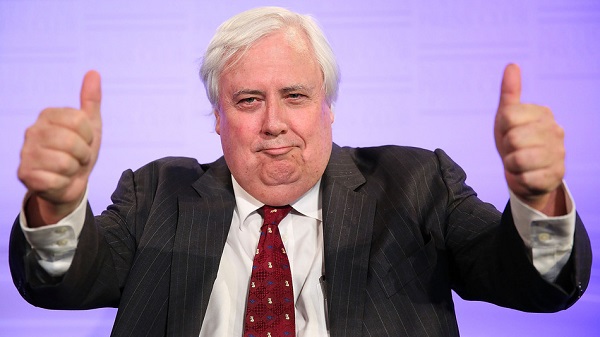
Meanwhile here on the local scene PUP are planning to introduce their ETS on trainer wheels as an amendment to the legislation proposing the demise of the Climate Change Authority.
Driving down new car emissions using offset credit trading
Most cars last for years. This means that a failure to reduce the average emissions of new cars now will damage the environment for many years to come. This post looks at the use of offset credit trading to drive down the average emissions of new cars as well as a few other actions that would help. Continue reading Driving down new car emissions using offset credit trading
The consequences of vertical fiscal imbalance
This is belated, but I still think worthwhile.
Jess Hill’s cracking article in The Monthly (you can read a limited number of articles online per month without a subscription), and the recent Four Corners program on renewable energy, are required consumption for anybody interested in the history and future of electricity supply in Australia.
In short, the electricity distributors (who hold a natural monopoly over their corner of the market) predicted continued growth in electricity demand and then persuaded the energy regulators to let them increase their charges to pay for said infrastructure. This accounted for most of the growth in electricity prices, despite the nonsense about the carbon tax from the right of politics. The reasonableness of these predictions can be debated; the fact that they led to massive profits for the distributors is now clear. In the face of these increased prices, something amazing happened – absolute demand for electricity dropped substantially. Part of this can be attributed to rooftop solar, some to energy efficiency; regardless, the huge infrastructure spend has turned out to be almost completely unnecessary. Along the way, grid electricity generators have felt the squeeze between falling demand and mandated construction of renewable energy through the RET, and are now lobbying hard to prevent more renewable energy being connected to the grid.
The future is a topic for another post, but there is one point about the past and present that Hill’s excellent report hasn’t really gotten in to. Particularly in NSW and Queensland where the price increases have been greatest, the electricity distributors are state-owned, and the profits have gone to the state governments. Dividends from the distributors have filled a pretty substantial gap in those state budgets; however, they’ve done so in an extremely inefficient way. Billions of dollars has been wasted building unnecessary infrastructure so that the state governments could collect revenue from the monopoly profits. Hill’s article reports $45 billion dollars worth of infrastructure has been built nationally; in Victoria’s privately run grid, one third of the infrastructure spending went towards peak capacity augmentation, whereas in NSW and Queensland about two-thirds was spent on the same area. Based on this, my rough guess is that in those two states, at least $7-8 billion was spent on unnecessary capacity augmentation.
In a sane world, if state governments need more revenue, they would raise taxes. But because of Australia’s strange fiscal arrangements, where state governments spend a large fraction of total government revenue but only collect a fraction of it, it’s easier to whinge about the vicissitudes of the Commonwealth Grants Commission and raise this kind of hugely inefficient stealth tax.
So next time somebody mentions “vertical fiscal imbalance” and “narrow tax bases”, try not to let your eyes glaze over. It’s boring, but it’s important.


